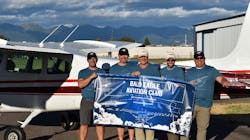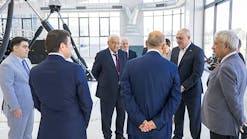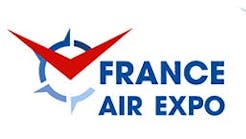AOPA's You Can Fly Program Recognizes 150th Flying Club
The Aircraft Owners and Pilots Association recently celebrated helping to create 150 new flying clubs since the Flying Clubs initiative within the You Can Fly program began about five years ago.
The Bald Eagle Aviation Club in Kalispell, Montana, was recognized as the 150th club. The club operates a 1957 straight-tail Cessna 182A from Kalispell City Airport in Montana.
“Wow—150—that’s pretty cool,” said co-founder Kevin Collom, who began flying lessons in 2018 and recently learned that his club helped the initiative reach the milestone. “I’d read about flying clubs and decided to check into our area because I’d heard there was one here years ago.”
The city has two airports—Kalispell City Airport straddles the south, and Glacier Park International Airport is to the north “which is closer to me and where I started my flight training,” said Collom.
Future founder Mike Whitehill, based at Kalispell City Airport, volunteered during the 2018 AOPA Fly-In at Missoula International Airport and attended a “Maximum Fun—Minimum Cost” flying club seminar. He hoped to duplicate his Minnesota flying club experience after a move out West and huddled with AOPA Flying Clubs Initiative Director Steve Bateman for additional advice.
“Mike found me in Missoula, and we chatted about it,” recalled Bateman. “Lots of phone calls and encouragement” followed. “Because we work with individuals, we know others who have common aviation goals, and we’re able to put them together. That’s exactly what happened with Kevin and Mike.”
“I remember Steve asking, ‘How close are you to Lakeside, Montana?’ because he heard from another pilot who was thinking about starting a flying club at Kalispell City Airport,” said Collom. When the two finally connected, “We said, ‘Shoot, this is a no-brainer.’ We kind of put our heads together and said, ‘Let’s move forward.’ It’s awesome. We’re pretty happy.”
“We love all of our new clubs,” said Bateman, who founded his own flying club in Maryland centered around a 1980 Cessna 152 Aerobat. “Bald Eagle went through tough times trying to find members before taking a leap of faith,” explained Bateman. “They bought the airplane, they created the club, and as soon as other people could see that it was real, they became believers,” too.
Bald Eagle Aviation Club operates the 182A with a Horton STOL conversion for better performance at high-altitude airports. Monthly dues are $150, and members are charged a $120 wet rate per tachometer hour. The initial club membership is $2,050 and is transferable. There are currently seven members, and the group has been up and running for about four months, said Collom, who added that scheduling the aircraft among the members hasn’t been a problem despite a flurry of recent activity. “We just graduated our first student about two or three weeks ago. His dad, George Weyl, is a club member and a CFII, so the two flew to finish up the private pilot requirements and prepare for his son Kelvin’s checkride.”
Bald Eagle’s first meeting included a photoshoot with a banner AOPA sent to help celebrate the 150th club milestone. An airplane wash and a hangar get-together are in the club’s future, and Collom said members are already talking about buying a complex high-performance aircraft.
“We’ve put a lot of time, a lot of money, and a lot of hard work into putting this thing together, and we couldn’t have done it without Steve’s help,” Collom said.
“Kevin and I were both very committed to forming a flying club, but it was a long process,” said Whitehill, who advised potential club founders to “be patient and be persistent. We love aviation and we want to share it with others and encourage them to start flying. That’s the neat thing about flying clubs.”
Support from the AOPA Flying Clubs Initiative was “invaluable to the club in its journey from startup to operational,” Whitehill concurred, emphasizing that help was just a phone call away. “Thank you, coach Bateman. Thank you, AOPA. You are the best!”





